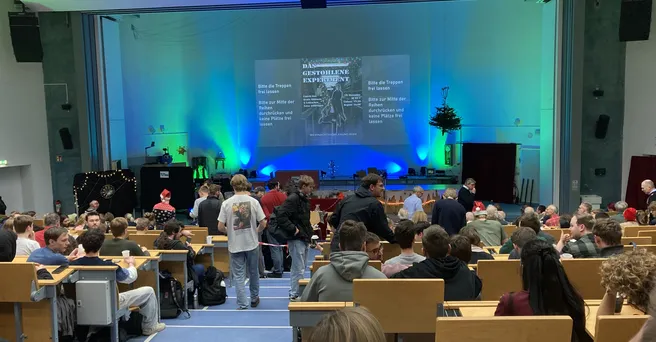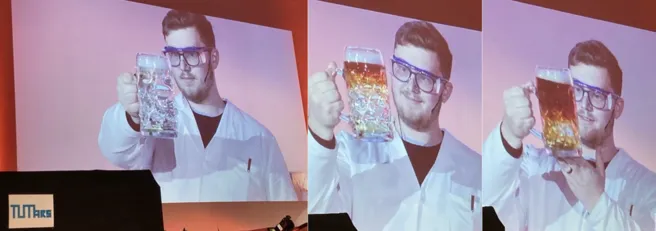In front of a fully packed audience in the Friedrich L. Bauer auditorium, NAT School students presented “The Stolen Experiment”, a humorous end-of-year play filled with spectacular live demonstrations.
Welcomed by Christmas carols and the smell of mulled wine, the audience entered the auditorium in eager anticipation, armed with their own mugs. This year’s Christmas lecture featured main characters Prof. Sophie Breuer, portrayed by Julia Penner, and drop-out physics student-turned-detective Clara Kern, portrayed by Anastasiia Abielian.
Set about 500 years in the future at TUMars, Det. Kern sets out on a quest to retrieve an experiment critical for the professional future of Prof. Breuer and apparently stolen by PhD student Paul Aner. Providing “enlightening” and mesmerizing insights into academia, the play featured a multitude of scientific experiments that the audience could follow on a big screen.
How to trap a Paul?
From quantum-eraser to coin-shrinker, the lecture featured a broad scope of experiments. As the main perpetrator of the play was named Paul, the obvious way to catch him was of course the “Paul (particle) trap”, named after Nobel laureate Wolfgang Paul, though there did seem to be a slight misunderstanding about the dimensions of the trap…
Beat your Prof
Blowing out candles may seem trivial, but how do you blow out a candle from several meters distance? Prof. Jonathan Finley and teaching coordinator Moritz Feil were invited on stage to face two students from the audience in a battle to build a vortex canon able to blow out the opponent’s candle. Armed with a bucket and duct tape, team Finley-Feil managed to narrowly beat the student team, at the end of which Prof. Finley performed a PowerPoint karaoke (his own words) explaining the physics behind the experiment. During a second round of “Beat your Prof”, Prof. Tom Nilges faced another student from the audience in an attempt to explain an apparent perpetuum mobile. Though Nilges’s explanation was deemed the more creative by the moderators, the audience hailed the student as the winner.
From one-off to tradition
Originally a Physics-only event, the Christmas lecture is becoming a NAT School tradition, where you have to be sure you come in early to guarantee a seat. However, it all started as a one-off when, in December 2007, Sepp Kressierer turned the preparation of new demonstration experiments for lectures as developed by the teacher-training students of the year into an experiment-filled fun lecture. Due to its overwhelming success and the ensuing demand for more, the Christmas lecture has become an annual event under the patronage of Prof. Christian Pfleiderer (Chair of Experimental Physics on the Topology of Correlated Systems). During the Corona years (2020 and 2021), no live audience was allowed, instead the event could be followed via a video stream.
Behind the scenes
Preparations for the Christmas lecture start as early as January, when the first brainstorming sessions of interested students about the next lecture takes place. The aim is to devise a plot combined with appropriate experiments, introducing at least two or three new experiments.
This year, Philipp Asbeck and Omar Abdelrahman faced the hard task of coordinating the entire event. Students, both experienced and new, were divided into 5 teams: script, experiments, stage set, technical and acting. Depending on the assumed tasks, time-investment is variable but may include coming in during evenings and weekends. Students registered for the course “Preparation of the Christmas lecture” (practical training 0000004531) receive 3 ECTS, though for many this is no reflection of the actual time invested. Rather, participating in the Christmas lecture is thought to be highly motivating, as for once you can perform the actual experiments you hear about during lectures. Alternatively, it may may simply provide an opportunity to live out your creative side. Also, from an organizational perspective, Asbeck and Abdelrahman found the Christmas lecture very stimulating and a great learning experience they would recommend to everyone.
Support
The Christmas lecture would not be possible without the help and contributions of many people. As patron of the event, Pfleiderer has a crucial role giving feedback and aiding students when needed. In this years’ lecture Prof. Peter Fierlinger was instrumental to the introduction of the coin-shrinker experiment, the explosive nature of which requiring some demanding fine-tuning, acting also as a second contact person for the students. Thanks to Finley and the MPQ PhotonLab, the quantum eraser was introduced to the lecture. Importantly, Kressierer and Fabian Eder provided major practical support, not only in the building up/breaking down of experimental set-ups, but also helping the students find the right experiments. For this, they voluntarily came in on weekends and during other out-of-office hours.
Interested?
Interested in participating in the 2025 Christmas lecture? Feel free to stop by at the MPIC student council office in the physics department, or send an email to: weihnachtsvorlesung(at)fs.tum.de. Many hands are needed and all help is appreciated.
The AStA and RBG provided the technical equipment and organized the livestream of the lecture. An edited version of the livestream is now available to watch on YouTube (https://www.youtube.com/watch?v=-2odFYy7mCs). Finally, the association “Friends and supporters of Physics at TUM” provides financial support for the stage decoration and general sponsoring of the Christmas lecture, including free mulled wine (or punch for children) and gingerbread.
Further information and Links
Prof. Pfleiderer, Chair of Experimental Physics on the Topology of Correlated Systems
Prof. Fierlinger , Chair of Precision Measurements at Extreme Conditions
Prof. Finley , Semiconductor Nanostructures and Quantum Systems
- Verein Freunde und Förderer der Physik an der TUM
Press contact




